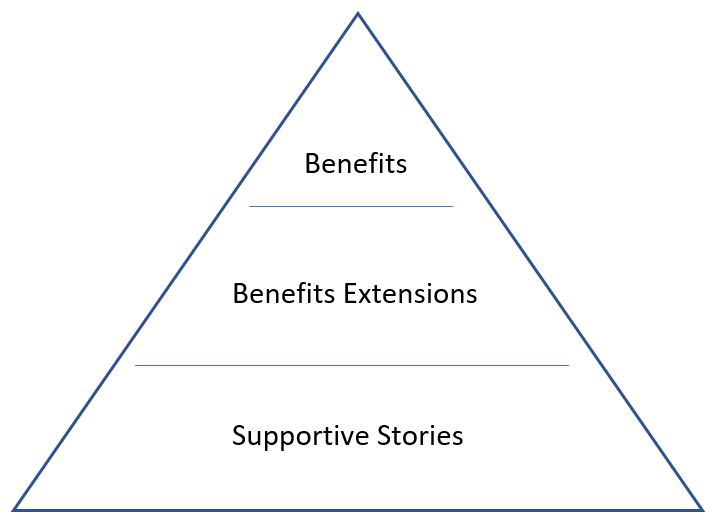The Sales Pyramid is a framework I developed to help you gather your sales pitch into a logical process.
Think of it as a way to structure an elevator pitch... that doesn't suck.
The reason why it works is that it gets right to the point of what your prospects want to get – either more money, more time, or both. In fact, those are usually the core benefits you want to start with, no matter what your business is.
Picture a pyramid with three levels. On the top of the pyramid are your three core benefits, which should have to do with time or money.
So think: How do you make people money, save them money, give them more time or save them time?
The reason why anyone hands over their own money is to get value from the exchange – usually in the form of time or money, but admittedly not always.
For instance, if you run a spa, a core benefit might be to leave you relaxed and refreshed. But why would you want to be relaxed and refreshed? So you can be a better business person, better spouse, or better human being.
In this case, the end-benefit isn’t relaxation, per se… it’s to improve a tangible outcome in the real world, i.e. being able to get more done, focus better or gain mental clarity.
Now, we’ve entered into the second layer of the pyramid. If the first stage is the core benefit "relax your mind and body," the second benefit (what I call a benefit extension) answers the "so what?" question.
Your benefit extension always begins with, "so that..."
For example:
At X Spa, we relax your mind and body (core benefit) so that you can go back to work with more focus, more clarity, and more drive to get your biggest goals accomplished (benefit extension).
In your pyramid, each core benefit on top must be underpinned by a benefit extension in the middle layer.
The third layer is for writing down stories that support your benefit extension and, ultimately, your core benefit.
For instance, if you’re the spa owner, you might want to go on to tell your prospect about a time when you weren’t focusing well at work.
Perhaps... you were losing your temper or burning out, and it affected your happiness and your ability to make money. Then, you started having regular spa treatments and you began to notice that you weren’t just relaxed afterwards, but energized and clearly focused on your work goals, which was a totally unexpected but awesome result.
When you do this, you’re helping your prospect understand two things:
- Whether you "get" them and truly understand what they need, and
- That you are clearly experienced in solving their core, underlying challenges.
Here's the Sales Pyramid at a glance:

If you don’t have one of these for your business, sit down and write yours up. It’ll be the backbone of your entire pitch, and over time you can add more benefits and more stories that you change depending on to whom you’re speaking (as any good sales presentation should).
Put yours up on social media and tag me so I can see your progress!
Here's a quick-start guide to creating your Pyramid:
- At the top of your Sales Pyramid, put your 3 greatest benefits. These should be time or money related (grow your revenues, save more money, spend less time, etc.)
- On the next level, explain how you give your customers each of those benefits. Let's say your customers are veterans, and you sell mortgages. Your process should flow like this:
Benefit: I help veterans save time…
Benefit Extension: ...so that they can spend more time planning their move rather than being stuck doing endless paperwork. - The bottom of your Sales Pyramid should have a true, personal story related to the benefit and explanation. So, after you’ve told your customer (veteran) that you save them time (benefit) so that they can spend more time with their family planning the move (benefit extension), it’s time to tell them a story that helps them understand why this is important.
For instance: When I was looking for a house 10 years ago, I was so frustrated. Everywhere I went to get a mortgage, it took DAYS to get me an answer. I’m used to things running like clockwork, and I had a family to manage who wanted to know the details of our next move. All I wanted to do was spend more time with them planning the exciting stuff, and instead I had to spend 10 hours in a stupid office with no windows signing papers! After that, I committed myself to making this process faster and easier for my own customers.
Pro Tip: Use this as a sort of sales script when you’re out talking to prospects, and pick the right story for the prospect you have at hand – which means listening to their personal needs and matching your story to what they’re looking for!
